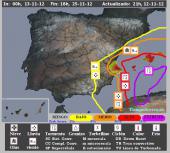Letra N
- N - CA - Cloud-to-Air lightning. BRN - See Bulk Richardson Number. NEXRAD - NEXt-Generation Weather RADar. Technologically-advanced weather radar being deployed to replace WSR-57 and WSR-74 units. NEXRAD is a high-resolution Doppler radar with increased emphasis on automation, including use of algorithms and automated volume scans. NEXRAD units are known as WSR-88D. NEXRAD - NEXt-Generation Weather RADar, rádar meteorológico de siguiente generación. Rádar meteorológico tecnológicamente más avanzado siendo utilizado para reemplazar las unidades WSR-57 (Weather Surveillance Radar ó Radar Meteorológico de Vigilancia) y WSR-74. NEXRAD es un radar Doppler de alta resolución con un especial énfasis en la automaticación, incluyendo el uso de algoritmos y escaneos de volumen automáticos. Las unidades NEXRAD se conocen como WSR-88D. Equilibrium Level (or EL) - On a sounding, the level above the level of free convection (LFC) at which the temperature of a rising air parcel again equals the temperature of the environment. (See sounding.) CC - Cloud-to-Cloud lightning. Nocturnal - Related to nighttime, or occurring at night. Nocturno/a - Relacionado con las horas de la noche, o que ocurre durante la noche. CG - Cloud-to-Ground lightning flash. Positive CG - A CG flash that delivers positive charge to the ground, as opposed to the more common negative charge. Positive CGs have been found to occur more frequently in some severe thunderstorms. Their occurrence is detectable by most lightning detection networks, but visually it is not considered possible to distinguish between a positive CG and a negative CG. (Some claim to have observed a relationship between staccato lightning and positive CGs, but this relationship is as yet unproven.) NT positivo - Rayo NT que lleva carga positiva hasta el suelo, como el opuesto a la carga negativa, que es la más común. Los NTs positivos ocurren más frecuentemente en algunas tormentas severas. Su ocurrencia es detectable por la mayoría de las redes de detección de rayos, pero visualmente no se considera posible distinguir entre un NT positivo y NT negativo. (Algunas afirmaciones contemplan una relación entre los rayos “staccato” y los NTs positivos, pero esta relación no está aún probada). Accessory Cloud - A cloud which is dependent on a larger cloud system for development and continuance. Roll clouds, shelf clouds, and wall clouds are examples of accessory clouds. Rope Cloud - In satellite meteorology, a narrow, rope-like band of clouds sometimes seen on satellite images along a front or other boundary. The term sometimes is used synonymously with rope or rope funnel. Nube Cuerda - En Meteorología de satélites, banda de nubes estrecha, parecida a una cuerda, que aveces se ve en las imágenes del satélite a lo largo de un frente u otra frontera. El término a veces se usa como sinónimo de cuerda. Debris Cloud - A rotating "cloud" of dust or debris, near or on the ground, often appearing beneath a condensation funnel and surrounding the base of a tornado. Funnel Cloud - A condensation funnel extending from the base of a towering cumulus or Cb, associated with a rotating column of air that is not in contact with the ground (and hence different from a tornado). A condensation funnel is a tornado, not a funnel cloud, if either a) it is in contact with the ground or b) a debris cloud or dust whirl is visible beneath it. Comma Cloud - A synoptic scale cloud pattern with a characteristic comma-like shape, often seen on satellite photographs associated with large and intense low-pressure systems. *Roll Cloud - A low, horizontal tube-shaped arcus cloud associated with a thunderstorm gust front (or sometimes with a cold front). Roll clouds are relatively rare; they are completely detached from the thunderstorm base or other cloud features, thus differentiating them from the more familiar shelf clouds. Roll clouds usually appear to be "rolling" about a horizontal axis, but should not be confused with funnel clouds. *Nube Rodillo – Nube arcus baja, con forma de tubo horizontal, asociadas con el frente de racha de una tormenta (o a veces con un frente frío). Las nubes en rodillo son relativamente raras; están completamente separadas de la base de la tormenta o de otros rasgos de la nube, y así diferenciándose de las más familiares nubes en estantería. Las nubes rodillo normalmente aparecen “rodando” sobre un eje horizontal, pero no deben ser confundidas con las nubes embudo. Knuckles - [Slang], lumpy protrusions on the edges, and sometimes the underside, of a thunderstorm anvil. They usually appear on the upwind side of a back-sheared anvil, and indicate rapid expansion of the anvil due to the presence of a very strong updraft. They are not mammatus clouds. See also cumuliform anvil, anvil rollover. Nudillos - [Construcción vulgar], protuberancias grumosas en los bordes y, a veces, en la cara inferior de un yunque tormentoso. Generalmente aparecen en la cara por la que sopla el viento de un yunque cortado hacia atrás e indica la rápida expansión del yunque debido a la presencia de un potente chorro ascendente. No son mamas (mammatus). Ver también yunque cumuliforme, yunque retorcido. Bulk Richardson Number (or BRN) - A non-dimensional number relating vertical stability and vertical shear (generally, stability divided by shear). High values indicate unstable and/or weakly-sheared environments; low values indicate weak instability and/or strong vertical shear. Generally, values in the range of around 50 to 100 suggest environmental conditions favorable for supercell development.
|
© Spain Severe Weather 2010








